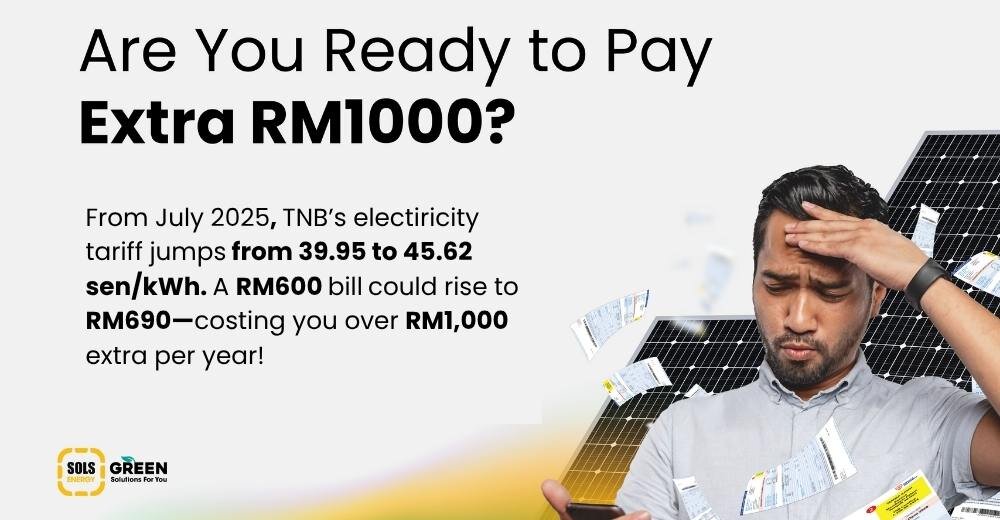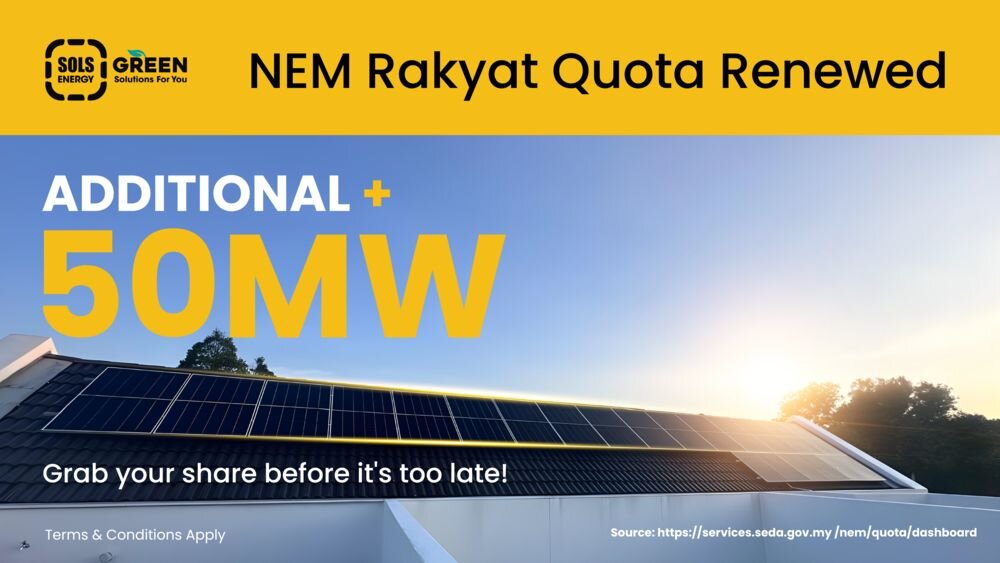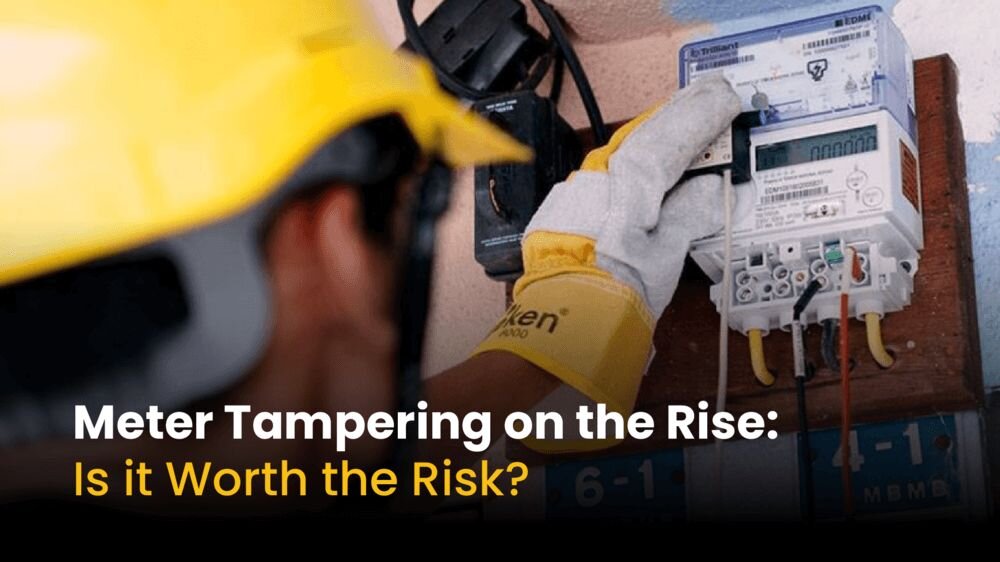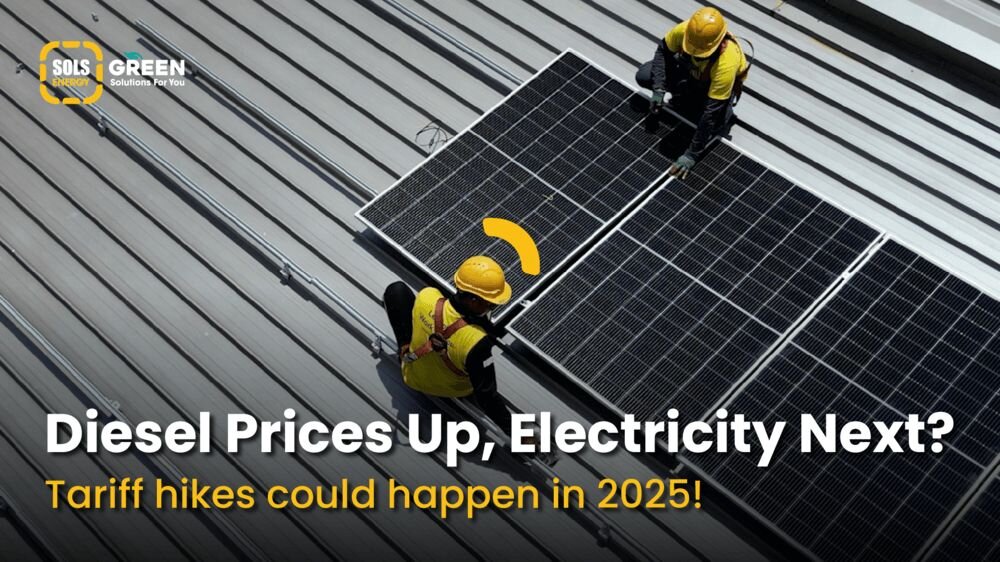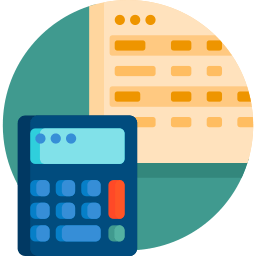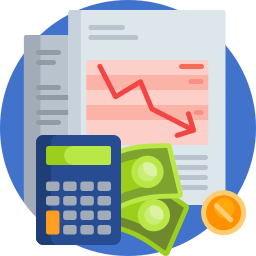A Guide: How to Read and Understand Your Monthly TNB Bill
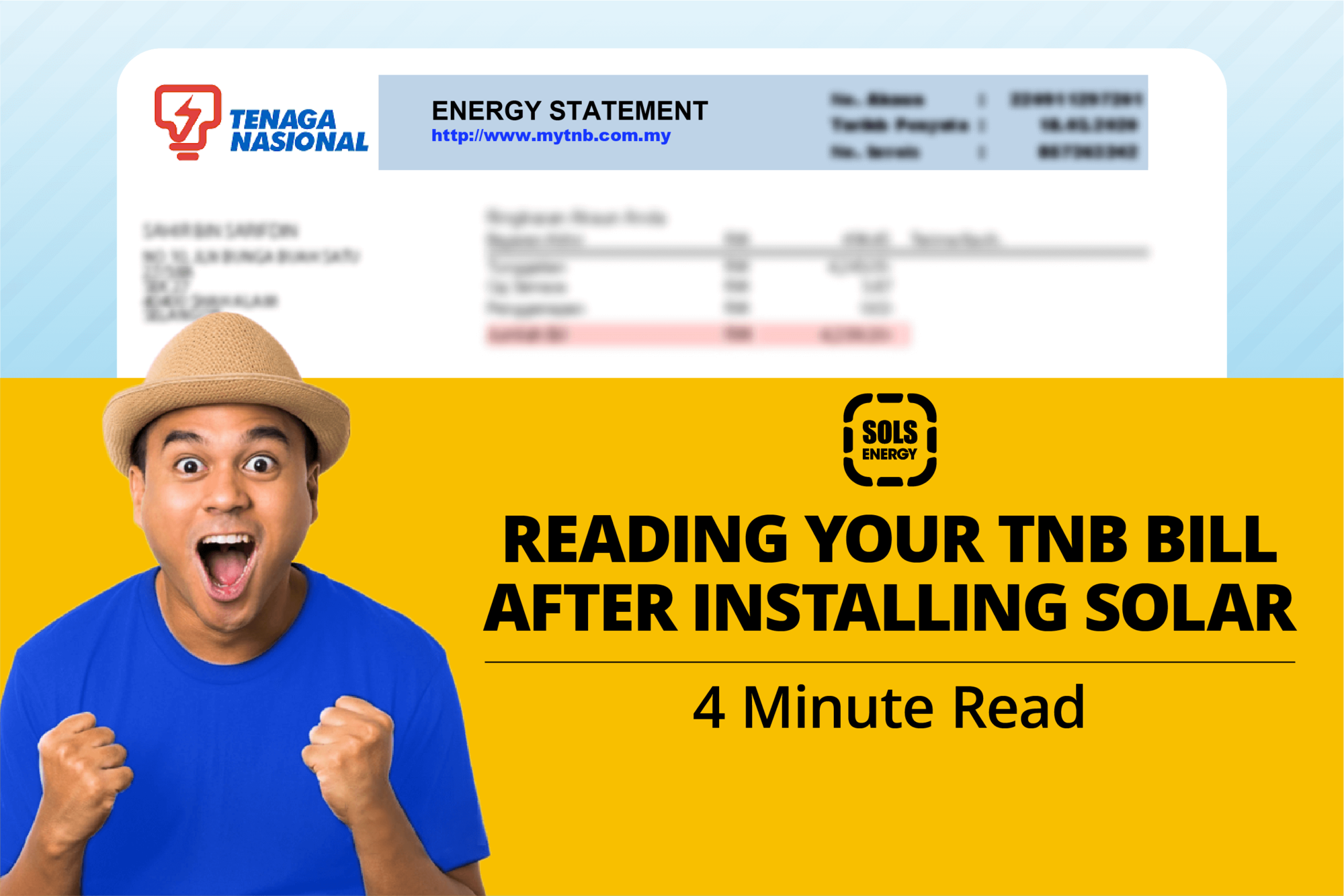
Are you the owner of a brand new Solar PV System? If yes, congratulations!
Skip to FAQ section for some direct answers.
The dreaded task of receiving an electricity bill is now a source of excitement as it can show you how much you have saved and how little you would have to pay for electricity in comparison to the past.
So, when will you see the savings reflected in your Tenaga Nasional Berhad (TNB) bill?
Here is a guide on how to read the electricity bill of your solar-powered home located in Malaysia.
TNB Bill No. 1: Pre Solar Installation
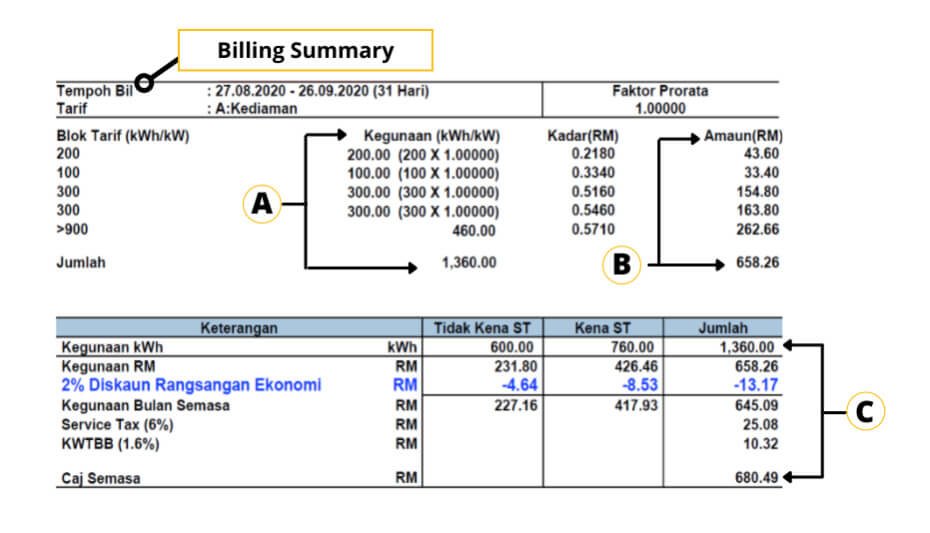
Ms. H’s TNB Bill – August 2020
Here is an actual TNB bill from one of our customers at SOLS Energy. This customer has not installed a solar PV system, and is still completely dependent on TNB for electricity needs.
The bill reflects the amount of electricity imported from the TNB electrical grid.
Under the billing period (Tempoh Bil) section we can see their billing summary.
(A) – Shows the energy consumption (Kegunaan (kWh/kW) for the whole of that month, in this case, the customer imported 1,360 kWh to power their home for the month of August 2020.
(B) – Shows the prices set by the TNB (blok tarif) prices and how much the energy consumption amounts to.
(C) – The final calculation for how much a home-owner is being charged. TNB (blok tarif) prices + service charge (6%) + KTWBB (1.6%). In this case, RM 680.49 is the total bill for energy consumption of that month (Caj Semasa).
Difference between Pre and Post Solar PV Installation Bill
The TNB bill of a solar-powered home-owner will have additional components. This is because of the Net-Metering system (NEM).
The concept of NEM is that energy produced from the installed solar PV system will be consumed first (directly powering your home), and any excess energy will be exported to TNB on a “one-to-one” basis. Usually, it is during the day where most of the residents are not at home and there is low consumption at home.
When the sun rises, the PV system begins generating power and saving it. As energy is needed less during the day-time, it is exported to the TNB grid, which proceeds to offset this customer’s bill. Once the sun sets, the energy consumption increases and electricity is imported from the TNB grid.
This process will now be reflected on the customer’s electricity bill.
The excess energy offsets your bill, thus, the amount of energy exported will be deducted from the amount of energy imported. The amount that is left will then be the only amount due for payment.
To put it simply:
- Energy produced by Solar Panels = used first by the house.
- Any extra energy not used by the house before night = exported/sold to TNB (1-to-1 basis)
- Energy used at night from TNB grid = Charged to home-owner
Every month, energy used by HomeOwner (+service charge + KTWBB) – Extra energy exported to TNB = Caj Semasa
Let’s see how it looks on a real TNB bill:
TNB Bill No. 2: Post Solar Installation
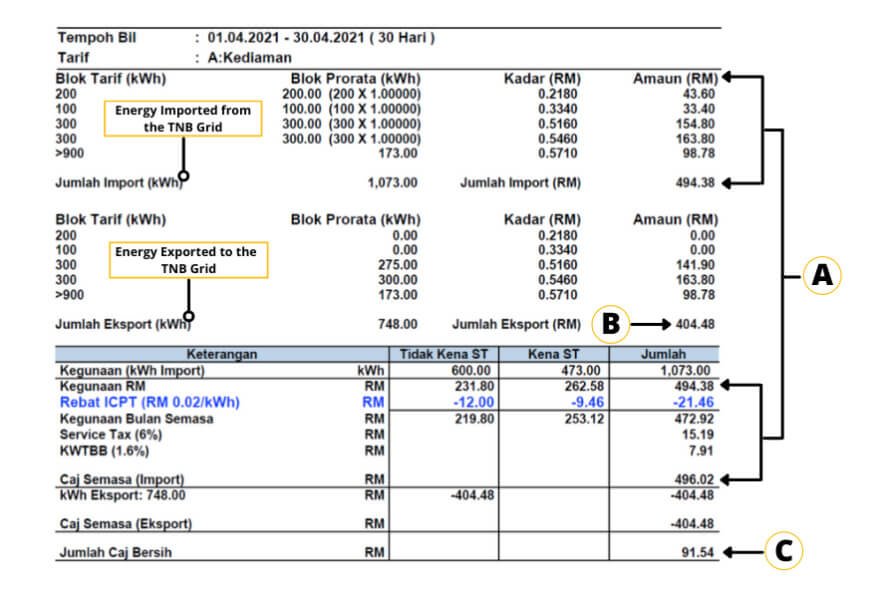
Ms. H’s TNB Bill – April 2021
TNB Bill No. 2 was charged to the same customer after the Solar PV System had been installed. The NEM system is now applicable to this customer.
As you can see, there are now two rows of billing summaries in comparison to TNB bill No. 1.
The first row shows how much kWh was imported from the TNB grid into the house.
The second row shows the amount of energy exported from the customer’s house to the TNB grid.
In the month of April 2021:
(A) – Customer imported/used 1,073 kWh (Blok Prorata). Adding service tax charge (6%) and KWTHBB (1.6%), their energy consumption would have cost them RM 496.02 (Jumlah Import).
(B) – Customer exported 748 kWh of electricity to the TNB grid. TNB offset their bill by RM 404.48.
(C) – The customer has to pay TNB RM 91.54 (Jumlah Caj Bersih) for their bill this month.
RM 496.02 – RM 404.48 = RM 91.54
The customer saved 86.55% for the month of April 2021 alone.
Baki Nem
In addition to this, if the amount of energy exported is more than the amount of energy imported from the TNB grid, the excess credit will be applied to the next month. For example:
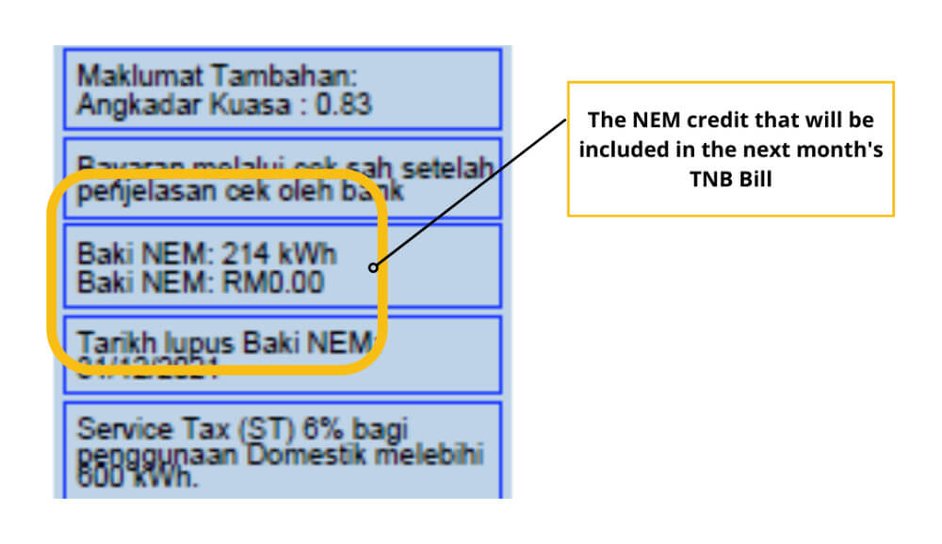
Located at the bottom right corner of the TNB Bill is Baki Nem. According to this bill, the excess energy exported is 214 kWh. It does not amount to anything in this bill, however, will be used to reduce the total in the next month. This applies to every solar-powered homeowner.
And there you go! That is how you can read your TNB monthly electricity bill to see the progress of NEM and how much money it is saving you in accordance with how much energy you are exporting into the TNB grid.
If you have installed solar with SOLS Energy, then we thank you for becoming one of our #SolarHeroes.
If you have any further questions on how to read your TNB bill, kindly contact our Customer Success Department and we will be happy to help.
Thank you and take care.
Frequently Asked Questions (FAQ)
1. What are the benefits of installing solar panels for my home/office/factory?
The benefits of going solar are:
- By installing a solar energy system, you save on your electricity bills; up to 100% savings are possible. During the day, you power your premises using solar energy, which lowers your dependency on your utility company, and if you produce more than you consume, you can sell the excess energy back to your utility company via Net Metering (NEM) which may be used to offset part of electricity bill (http://seda.gov.my/ )
- Installing solar panels increases your property value. Studies have shown that properties with solar panels are valued and sold at a price higher than other comparable properties in its general vicinity.
- Solar energy is a form of clean, renewable energy like wind, which significantly helps lessen your carbon footprint on the environment. Unlike traditional electricity, it does not pollute the atmosphere with harmful greenhouse gas emissions, which are sourced from fossil fuels such as coal, natural gas & diesel. They emit harmful gases causing air pollution and global climate change.
- Since solar energy is renewable energy, it requires little to no maintenance. Once you have installed them, there is no need for regular maintenance checks. It allows you to generate solar power for a lifetime without depending on your utility company and deal with the constantly rising electricity rates. Your future generation may also benefit from it.
- Companies undertaking generation of renewable energy and energy efficiency activities are eligible for special tax incentives; Investment Tax Allowance (ITA) (http://www.seda.gov.my ) (http://www.mida.gov.my/home/tax-incentives-for-green-industry/posts/)
- Home owners in Petaling Jaya can enjoy Assessment Tax Rebates for adapting to eco living and sustainable lifestyle (http://eps.mbpj.gov.my/web2016/RebatCukai2016English.pdf)
2. How much would it cost to install solar panels for my home/office/factory?
The cost would depend on our power study and space on the roof.
3. What is net metering?
Net metering is when you have a solar system installed, and during the day, when the sun is out, it will power your home, and when the sun sets, the home gathers its electricity from the primary power grid.
4. I heard that we could earn money by installing solar panels; how is that?
How the earnings work are by savings, so the more solar energy used, the less is used by the leading power companies, saving you from having to pay them for electricity. On top of that, whatever excess energy is produced, it is sold to the leading power companies for 31 cents per kW. This will be used to offset your next TNB bill.
5. Are there any hidden cost?
There are no hidden charges. All our charges will be presented transparently on the proposal we make for you. Any possible charges for processing commercial tax incentives and if special requirements are needed for the installation will be clearly stated and explained before you agree to the installation.
6. How much can you save by installing solar panels?
Savings vary based on your electricity consumption and installation size. On average, you can save anywhere between 20% and 40%.
Let Us Customize Your Solar
Fill in this form to claim your Free Power Study worth RM499.


